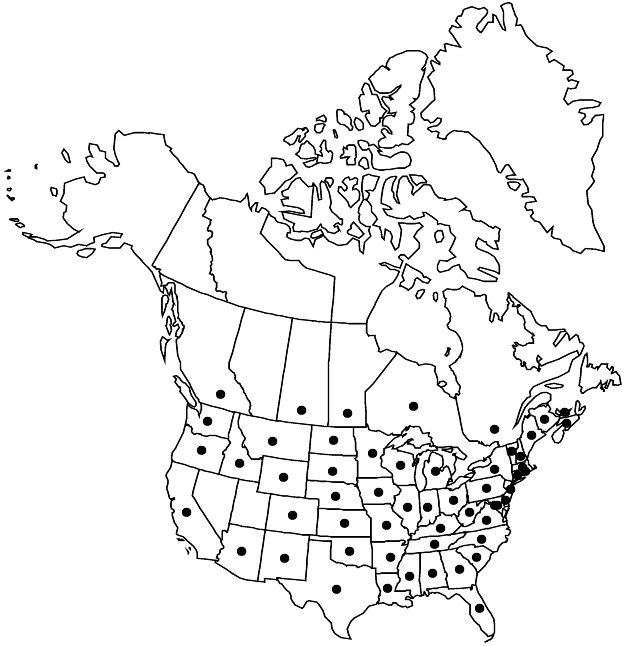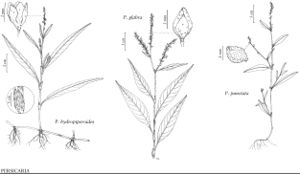Difference between revisions of "Persicaria punctata"
Fl. S.E. U.S., 379. 1903.
FNA>Volume Importer |
imported>Volume Importer |
||
| (5 intermediate revisions by 2 users not shown) | |||
| Line 8: | Line 8: | ||
}} | }} | ||
|common_names=Dotted smartweed;renouée ponctuée | |common_names=Dotted smartweed;renouée ponctuée | ||
| − | |basionyms={{Treatment/ID/ | + | |special_status={{Treatment/ID/Special_status |
| + | |code=W | ||
| + | |label=Weedy | ||
| + | }}{{Treatment/ID/Special_status | ||
| + | |code=F | ||
| + | |label=Illustrated | ||
| + | }} | ||
| + | |basionyms={{Treatment/ID/Basionym | ||
|name=Polygonum punctatum | |name=Polygonum punctatum | ||
|authority=Elliott | |authority=Elliott | ||
| + | |rank=species | ||
| + | |publication_title=Sketch Bot. S. Carolina | ||
| + | |publication_place=1: 455. 1817 | ||
}} | }} | ||
|synonyms={{Treatment/ID/Synonym | |synonyms={{Treatment/ID/Synonym | ||
|name=Polygonum acre var. leptostachyum | |name=Polygonum acre var. leptostachyum | ||
|authority=Meisner | |authority=Meisner | ||
| + | |rank=variety | ||
}} {{Treatment/ID/Synonym | }} {{Treatment/ID/Synonym | ||
|name=Polygonum punctatum var. confertiflorum | |name=Polygonum punctatum var. confertiflorum | ||
|authority=(Meisner) Small | |authority=(Meisner) Small | ||
| + | |rank=variety | ||
}} {{Treatment/ID/Synonym | }} {{Treatment/ID/Synonym | ||
|name=Polygonum punctatum var. ellipticum | |name=Polygonum punctatum var. ellipticum | ||
|authority=Fassett | |authority=Fassett | ||
| + | |rank=variety | ||
}} {{Treatment/ID/Synonym | }} {{Treatment/ID/Synonym | ||
|name=Polygonum punctatum var. leptostachyum | |name=Polygonum punctatum var. leptostachyum | ||
|authority=(Meisner) Small | |authority=(Meisner) Small | ||
| + | |rank=variety | ||
}} {{Treatment/ID/Synonym | }} {{Treatment/ID/Synonym | ||
|name=Polygonum punctatum var. parviflorum | |name=Polygonum punctatum var. parviflorum | ||
|authority=Fassett | |authority=Fassett | ||
| + | |rank=variety | ||
}} {{Treatment/ID/Synonym | }} {{Treatment/ID/Synonym | ||
|name=Polygonum punctatum var. parvum | |name=Polygonum punctatum var. parvum | ||
|authority=Marie-Victorin & Rousseau | |authority=Marie-Victorin & Rousseau | ||
| + | |rank=variety | ||
}} | }} | ||
|hierarchy=Polygonaceae;Polygonaceae subfam. Polygonoideae;Persicaria;Persicaria sect. Persicaria;Persicaria punctata | |hierarchy=Polygonaceae;Polygonaceae subfam. Polygonoideae;Persicaria;Persicaria sect. Persicaria;Persicaria punctata | ||
| Line 58: | Line 74: | ||
-->{{#Taxon: | -->{{#Taxon: | ||
name=Persicaria punctata | name=Persicaria punctata | ||
| − | |||
|authority=(Elliott) Small | |authority=(Elliott) Small | ||
|rank=species | |rank=species | ||
| Line 72: | Line 87: | ||
|publication title=Fl. S.E. U.S., | |publication title=Fl. S.E. U.S., | ||
|publication year=1903 | |publication year=1903 | ||
| − | |special status= | + | |special status=Weedy;Illustrated |
| − | |source xml=https:// | + | |source xml=https://bitbucket.org/aafc-mbb/fna-data-curation/src/2e0870ddd59836b60bcf96646a41e87ea5a5943a/coarse_grained_fna_xml/V5/V5_1197.xml |
|subfamily=Polygonaceae subfam. Polygonoideae | |subfamily=Polygonaceae subfam. Polygonoideae | ||
|genus=Persicaria | |genus=Persicaria | ||
Latest revision as of 22:08, 5 November 2020
Plants annual or perennial, 1.5–12 dm; roots also often arising from proximal nodes; rhizomes often present. Stems ascending to erect, branched, without noticeable ribs, glabrous, glandular-punctate. Leaves: ocrea brown, cylindric, (4–)9–18 mm, chartaceous, base inflated, margins truncate, ciliate with bristles 2–11 mm, surface glabrous or strigose, glandular-punctate; petiole 0.1–1 cm, glandular-punctate, leaves sometimes sessile; blade without dark triangular or lunate blotch adaxially, lanceolate to lanceolate-ovate or subrhombic, 4–10(–15) × 0.6–2.4 cm, base tapered or cuneate, margins antrorsely strigose, apex acute to acuminate, faces glabrous or scabrous along midveins, glandular-punctate. Inflorescences mostly terminal, sometimes also axillary, erect, interrupted, 50–200 × 4–8 mm; peduncle 30–60 mm, glabrous, glandular-punctate; ocreolae mostly not overlapping, margins mostly ciliate with bristles to 2 mm. Pedicels ascending, 1–4 mm. Flowers 2–6 per ocreate fascicle, homostylous; perianth greenish proximally, white distally, rarely tinged pink, glandular-punctate with punctae ± uniformly distributed, scarcely accrescent; tepals 5, connate ca. 1/3 their length, obovate, 3–3.5 mm, veins prominent or not, not anchor-shaped, margins entire, apex obtuse to rounded; stamens 6–8, included; anthers pink or red, elliptic to ovate; styles 2–3, connate proximally. Achenes included or apex exserted, brownish black, usually 3-gonous, rarely biconvex, (1.8–)2.2–3.2 × 1.5–2.2 mm, shiny, smooth. 2n = 44.
Phenology: Flowering Jun–Nov.
Habitat: Shallow water, shores, marshes, floodplain forests
Elevation: 0-1500 m
Distribution

B.C., Man., N.B., N.S., Ont., P.E.I., Que., Sask., Ala., Ariz., Ark., Calif., Colo., Conn., Del., D.C., Fla., Ga., Idaho, Ill., Ind., Iowa, Kans., Ky., La., Maine, Md., Mass., Mich., Minn., Miss., Mo., Mont., Nebr., N.H., N.J., N.Mex., N.Y., N.C., N.Dak., Ohio, Okla., Oreg., Pa., R.I., S.C., S.Dak., Tenn., Tex., Vt., Va., Wash., W.Va., Wis., Wyo., Mexico, West Indies (Puerto Rico), Central America (Guatemala), South America (Brazil), Pacific Islands (Hawaii).
Discussion
N. C. Fassett (1949) proposed a complicated classification for Persicaria punctata with 12 varieties in North America and South America. He also identified numerous specimens that he considered to be morphologically intermediate between various varieties. M. Dalci (1972) documented a wide range of phenotypic and genotypic variation throughout the range of P. punctata and extensive overlap in many of the features used by Fassett to distinguish varieties. Consequently, recognition of varieties does not seem warranted. Persicaria punctata and its close relatives P. robustior and P. glabra are unique among native North American smartweeds in possessing complex glands called valvate chambers in their epidermises. Persicaria punctata is confused most frequently with P. hydropiper; the achenes are diagnostic.
The Chippewa, Houma, and Iroquois prepared decoctions from leaves, flowers, and roots for use as analgesics as well as gastrointestinal, orthopedic, and psychological aids (D. E. Moerman 1998).
